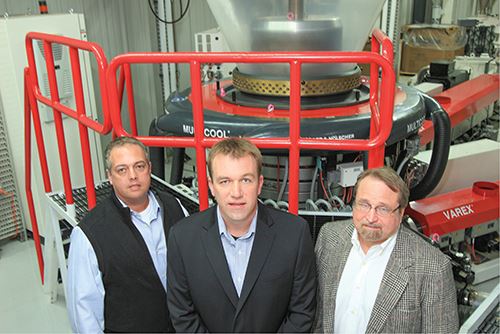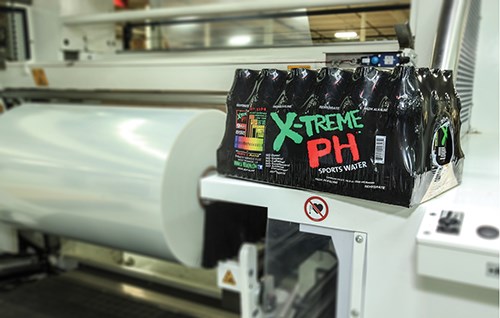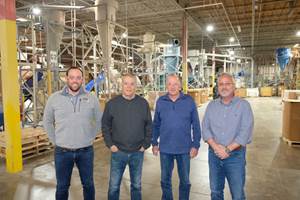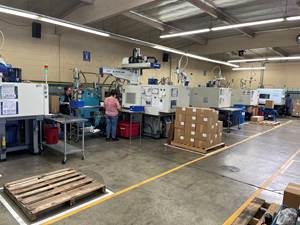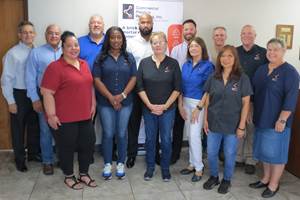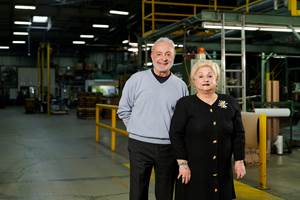From Printer to High-End Extruder: Colormasters Sets Sights on Collation Film
When long-established printing and converting company Colormasters was putting together a strategic plan for growth, it added blown film processing to the mix.
When you’re a 27-year-old company and already considered a preeminent player in your field, what can you do to grow your business?
Colormasters LLC was in such a quandary in 2012. Founded in 1986, the Albertville, Ala., firm (colormastersllc.com) had already earned a reputation as a technology leader and innovator in flexible packaging, focused on high-definition flexographic printing. It also performed a gamut of other “downstream” services, including solvent-free laminating and bag and pouch production. These and other value-added, post-processing services were performed on film that Colormasters bought from other firms, some of them big-name and well-established players.
Colormasters’ solution to its growth quandary was to invest in blown film extrusion—and not just by dipping its toe in the water. It formulated a strategic business plan and backed the plan with serious cash, investing $25 million in a new 50,000 ft² plant across the street from its printing and converting operation.
The plant currently houses four, three-layer blown-film lines from Windmoeller & Hoelscher Corp. (W&H), Lincoln, R.I., that are connected by a common tower. Each layer is fed by its own extruder. Each extruder is equipped with a six-component gravimetric blender, allowing the processor to tinker with blends to achieve the property balance to suit the application. Colormasters’ history with W&H goes back to 2008, when it ordered a Miraflex CM 10 flexographic printing press. In 2012, it added a Miraflex CL 10 press.
The plant was built with further expansion in mind. It can fit four more lines when they’re needed. Outside the plant are 14 resin silos that feed an operation that now has a name of its own, Master Extrusion, which has overall capacity of 50 million lb/yr.
“We’ve been growing regularly since we opened our doors,” notes Ben Fryer, general manager of the privately held company since it started up. “But we recognized that to grow at a faster level, we needed to add to our services. The strategic plan in 2012 had two main objectives: First, to back-integrate so as to better control quality and support what we had been doing since 1986 in printing, pouch making, and the like. But we also knew from the get-go that with this extrusion capacity we could not only support our existing business, but penetrate other markets as well. These two goals went hand in hand.”
You don’t just go from being primarily a printer to being a full-service supplier of multi-layer packaging film without a hiccup or two, but Colormasters kept the learning curve shallow by quickly bringing aboard people who knew the film business inside out. Before blowing its first bubble, Colormasters had hired Scott Ausmus as plant manager and Bob Chambliss as extrusion technical director. Both brought with them decades of experience in blown film extrusion. They had worked together at a couple of film processing plants for about 10 years. Chambliss, who also heads up the company’s R&D efforts, has a reputation as “one of the industry’s leading film designers,” says Ausmus.
“We took a look at the business plan and saw how aggressive the company was going to be in investing in new technology and pushing high-quality film into new markets,” Ausmus states. “It didn’t take much for us to recognize that this was going to be an exciting new opportunity.”
The two extrusion experts quickly recruited additional managers and operators, including four with whom Ausmus and Chambliss had worked at previous companies. Companywide, Colormasters employs 280, running three shifts 24/5. Roughly 10% of that total work force is devoted to the Master Extrusion operation.
Of the four coex lines from W&H, two are Optimex systems, which run up to 1200 lb/hr with working widths to 72 in. Two others are Varex lines that operate to 2000 lb/hr at widths to 110 in. Master Extrusion runs at thicknesses from less than 1 mil to 5 mils; variations are held to within ±3% of 2 sigma.
A sign that the right people and the right technology pay off, the Master Extrusion operation was making saleable product a few hours after the first line was strung, says Chambliss. Adds Fryer, “Because of our new technology, the reputations of the people we brought in to support it, and the fact that we already had a strong, 27-year stature as a leader in printing and various other operations, we actually had sales in place before the we even had capacity. And in short order, we were pretty much in a sold-out position.”
TARGET: COLLATION FILM
One primary market for the new extrusion capacity is collation film for beverages. Colormasters was no stranger to this market, having performed printing and other services on film furnished by other producers. But now, says Fryer, “We’re one of the first fully integrated blown film plants designed from the ground up for collation shrink film. This gives us a huge advantage.”
According to Chambliss, Master Extrusion’s collation shrink film is already opening eyes at several key beverage makers: “One of the major water manufacturers confirmed a 15% increase in uptime when using our film compared with what they had been using. And this particular application is for a large pack that has to nest without the cardboard bottom.”
Adds Ausmus, “If there is a beverage application that currently uses a cardboard base, we’ll be able to eliminate it.”
For collation applications, Master Extrusion runs at thicknesses of 2-4 mils. But Chambliss is currently developing recipes that could allow it to downgauge to 1.25-1.5 mil. And while the current capacity is exclusively three-layer, the firm has an open mind about moving to five layers or more on future lines if it becomes convinced there’s something to be gained. Says Chambliss, “We’re fully up to speed on blown film technology of any kind. For collation film, we’ll evaluate the technical advantages of five-layer systems, and if we feel that is where we need to be, that is where we’ll be.”
In film, the processor expects that the addition of four new lines within the next two years will increase sales to $250 million, two-and-a-half times the $100 million it is projecting for 2014. That will not be limited to collation film, as the company already has a footprint in various other film-packaging markets. It also would not rule out a move to barrier films in the future. Ausmus remarks, “The people we have already hired to support to Master Extrusion business all have a background in barrier film structures.”
Firmly behind all of this technology is a small-company mindset that considers customer service and quick turnarounds as building blocks. “We take a lot of pride in what we say is a ‘can do’ attitude,” says Fryer. “Once we get a customer, we keep a customer.”
The processor is also a “Green Power” partner with the Tennessee Valley Authority, its electricity provider, and purchases energy generated from sustainable sources. Generally only much larger firms operate this way with TVA. In fact, Colormasters was selected by TVA as its Green Power Switch Business Partner of the Year in 2013. “We are proud to be one of the ‘greenest’ blown film companies in the country,” Fryer states.
Related Content
Evolving Opportunities for Ambitious Plastics Recycler
St. Joseph Plastics grew from a simple grinding operation and now pursues growing markets in recycled PP, food-grade recycled materials, and customized post-industrial and post-consumer compounds.
Read MoreBack in the Family Business
In its 45th year, Precision Molded Plastics has carved out a technology and market niche, growing not just when opportunities arise but when they make sense, after its leader changed careers to keep the family business from changing hands.
Read MoreInside the Florida Recycler Taking on NPE’s 100% Scrap Reuse Goal
Hundreds of tons of demonstration products will be created this week. Commercial Plastics Recycling is striving to recycle ALL of it.
Read MoreGeneration Gap? Not at Packaging Personified
Started at a kitchen table and now in its third-generation of family involvement, this vertically integrated supplier of flexible packaging traces its success to closely aligning with customers and continually investing in new technology across its films, printing and converting operations.
Read MoreRead Next
People 4.0 – How to Get Buy-In from Your Staff for Industry 4.0 Systems
Implementing a production monitoring system as the foundation of a ‘smart factory’ is about integrating people with new technology as much as it is about integrating machines and computers. Here are tips from a company that has gone through the process.
Read MoreFor PLASTICS' CEO Seaholm, NPE to Shine Light on Sustainability Successes
With advocacy, communication and sustainability as three main pillars, Seaholm leads a trade association to NPE that ‘is more active today than we have ever been.’
Read More

